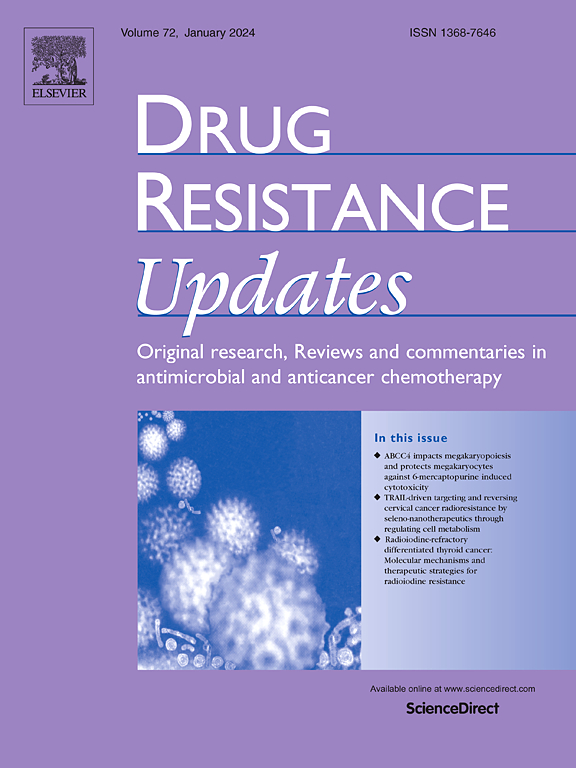靶向CLK1/SRSF7轴依赖性替代剪接使胰腺导管腺癌对化疗和免疫治疗增敏
IF 21.7
1区 医学
Q1 PHARMACOLOGY & PHARMACY
引用次数: 0
摘要
目的胰腺导管腺癌(pancreatic ductal adenocarcinoma, PDAC)的高死亡率主要是由于获得性耐药,尤其是对吉西他滨的耐药。本研究旨在阐明PDAC中吉西他滨耐药的潜在分子机制,揭示导致耐药的其他致瘤因子,并针对这一现象制定更有效、更安全的靶向治疗策略。方法采用环状RNA (circRNA)测序技术鉴定化疗敏感和耐药肿瘤之间表达差异的环状RNA。利用液相色谱-质谱法(LC-MS)揭示了α - 1,3 -葡萄糖基转移酶8 (cALG8)环状RNA相关的RNA结合蛋白(rbp)。应用分子生物学技术探讨cALG8在PDAC耐吉西他滨情况下的生物学功能及调控机制。单细胞测序揭示胰腺癌肿瘤免疫微环境组成的变化。采用患者源性类器官(PDO)和患者源性异种移植(PDX)进一步验证分子机制。最后,开发了靶向cALG8的反义寡核苷酸(ASOs)用于体内应用,并在小鼠模型中评估了它们的转化治疗潜力。结果本研究发现与选择性剪接相关的cALG8在耐吉西他滨PDAC细胞中高表达。cALG8调节选择性剪接复合体,从而促进PDAC的化疗耐药和免疫抑制。从机制上讲,高水平的cALG8通过其34-85 nt和109-160 nt区域作为蛋白质支架,为CLK1在231S位点磷酸化富含丝氨酸/精氨酸的剪接因子7 (SRSF7)创造了空间条件。这一过程促进了srsf7依赖性ataxa -毛细血管扩张突变(ATM)激酶变体ATM203的形成,提高ATM的翻译效率,从而促进PDAC细胞DNA损伤修复和免疫微环境重塑,以抵消化疗药物的作用。当与吉西他滨和抗程序性细胞死亡蛋白(PD)-1抗体联合使用时,一种破坏CLK1-SRSF7相互作用的calg8靶向ASO显著降低了PDX模型中的肿瘤负荷,验证了其治疗转化价值。结论cALG8/CLK1/SRSF7轴通过增强ATM203的剪接促进ATM的表达,从而促进了PDAC的吉西他滨耐药和免疫抑制微环境的形成。这一见解有助于开发针对PDAC中DNA损伤修复机制诱导的化疗耐药的药物。本文章由计算机程序翻译,如有差异,请以英文原文为准。
Targeting CLK1/SRSF7 axis-dependent alternative splicing sensitizes pancreatic ductal adenocarcinoma to chemotherapy and immunotherapy
Aim
The persistently high mortality rate of pancreatic ductal adenocarcinoma (PDAC) is largely attributed to the acquired resistance to chemotherapy, particularly gemcitabine. This study aims to elucidate the underlying molecular mechanisms of gemcitabine resistance in PDAC, uncover additional pro-tumorigenic factors contributing to drug resistance, and develop more effective and safer targeted therapeutic strategies against this phenomenon.
Methods
Circular RNA (circRNA) sequencing was employed to identify differentially expressed circRNAs between chemo-sensitive and resistant tumors. Liquid Chromatography-Mass Spectrometry (LC-MS) was utilized to uncover the RNA-binding proteins (RBPs) associated with circular RNA of alpha-1, 3-glucosyltransferase 8 (cALG8). Molecular biology techniques were applied to explore the biological functions and regulatory mechanisms of cALG8 in the context of gemcitabine resistance in PDAC. Single-cell sequencing was performed to reveal changes in the composition of tumor immune microenvironment of pancreatic cancer. Patient-Derived Organoid (PDO) and Patient-Derived Xenograft (PDX) were employed to further validate the molecular mechanisms. Finally, antisense oligonucleotides (ASOs) targeting cALG8 were developed for in vivo use, and their translational therapeutic potential was evaluated in mouse models.
Results
This study identified that cALG8, which is associated with alternative splicing, is highly expressed in gemcitabine-resistant PDAC cells. cALG8 regulates the alternative splicing complex, thereby promoting chemoresistance and immunosuppression in PDAC. Mechanistically, high level of cALG8 functions as a protein scaffold through its 34–85 nt and 109–160 nt regions, creating spatial conditions for CDC-like kinase 1 (CLK1) to phosphorylate serine/arginine-rich splicing factor 7 (SRSF7) at site 231S. This process facilitates the formation of the SRSF7-dependent ataxia-telangiectasia mutated (ATM) kinase variant, ATM203, enhancing the translational efficiency of ATM, and consequently promoting DNA damage repair and immune microenvironment remodeling in PDAC cells to counteract the effects of chemotherapeutic drugs. A cALG8-targeting ASO that disrupts the CLK1-SRSF7 interaction, when combined with gemcitabine and anti-programmed cell death protein (PD)-1 antibody, significantly reduced tumor burden in PDX model, validating its therapeutic translational value.
Conclusion
We demonstrated that the cALG8/CLK1/SRSF7 axis promotes ATM expression by enhancing the splicing of ATM203, thereby facilitating gemcitabine resistance and formation of an immunosuppressive microenvironment in PDAC. This insight aids in the development of drugs targeting chemotherapy resistance induced by DNA damage repair mechanisms in PDAC.
求助全文
通过发布文献求助,成功后即可免费获取论文全文。
去求助
来源期刊

Drug Resistance Updates
医学-药学
CiteScore
26.20
自引率
11.90%
发文量
32
审稿时长
29 days
期刊介绍:
Drug Resistance Updates serves as a platform for publishing original research, commentary, and expert reviews on significant advancements in drug resistance related to infectious diseases and cancer. It encompasses diverse disciplines such as molecular biology, biochemistry, cell biology, pharmacology, microbiology, preclinical therapeutics, oncology, and clinical medicine. The journal addresses both basic research and clinical aspects of drug resistance, providing insights into novel drugs and strategies to overcome resistance. Original research articles are welcomed, and review articles are authored by leaders in the field by invitation.
Articles are written by leaders in the field, in response to an invitation from the Editors, and are peer-reviewed prior to publication. Articles are clear, readable, and up-to-date, suitable for a multidisciplinary readership and include schematic diagrams and other illustrations conveying the major points of the article. The goal is to highlight recent areas of growth and put them in perspective.
*Expert reviews in clinical and basic drug resistance research in oncology and infectious disease
*Describes emerging technologies and therapies, particularly those that overcome drug resistance
*Emphasises common themes in microbial and cancer research
 求助内容:
求助内容: 应助结果提醒方式:
应助结果提醒方式:


